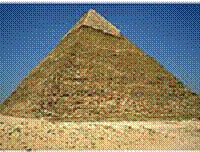 |

|
 |
Pyramid
Like almost all greats, Egyptian pharaohs were notoriously eccentric, but suppose there was one even more to the left field, Pharaoh Aziza, who decided, on the advise of the royal astrologer, to build her great pyramid under water. Let us assume that the unorthodox pyramid’s specifications were identical to those of Khufu’s Great Pyramid of Giza (2600 B.C.): height 153 m; base 241×241 m; angle of inclination of the triangular faces 51.5°; made of 2,300,000 dressed stone blocks each 2.5 tons. The unusual pyramid would have its apex 5 m below the air-water interface and its base would sit on the Mediterranean Sea bottom. As the royal engineer and fluid statics expert, your task is to counsel Pharaoh Aziza on what it would take to design a structurally sound underwater pyramid. As compared to a pyramid sitting in air, what additional forces would the underwater pyramid be susceptible to? Do not take the easy, and probably sane, way out and advise the abandoning of the project altogether.
Contributed by Mohamed Gad-el-Hak,Virginia Commonwealth University, Richmond, Virginia, USA. |
 |